 Tero Alstola. (2020) Judeans in Babylonia: A Study of Deportees in the Sixth and Fifth Centuries BCE. Culture and History of the Ancient Near East 109. Leiden: Brill.
Tero Alstola. (2020) Judeans in Babylonia: A Study of Deportees in the Sixth and Fifth Centuries BCE. Culture and History of the Ancient Near East 109. Leiden: Brill.
Judeans in Babylonia (Leiden: Brill, 2020) shows that the life of deportees 2,500 years ago can be studied in great detail. The majority of Judeans and other deportees were settled in the Babylonian countryside and given a plot of royal land to cultivate. In exchange, they had to pay taxes and perform work and military service. These people often lived in villages which were named after their geographic origin, the village of Yahudu – or “Judah” – being a prime example of this phenomenon. Some deportees found ways to benefit from the structures of local agriculture, and socioeconomic differences emerged over time. A number of Judeans were also settled in cities where they often worked as skilled professionals such as craftsmen, merchants, or officials. The state administration was open for people of foreign origin, partially because of the widespread use of Aramaic as a spoken and written language.
Deportees were not enslaved, and they could own property, engage in business activities, and travel at least locally. The practice of settling deportees in village communities according to their place of origin helped migrants to preserve their traditional culture in the countryside. Judean farmers had little interaction with the native population whereas the deportees living in cities met Babylonians on a regular basis. As a result, Judean farmers were less integrated into Babylonian society than their fellow deportees living in cities.
The book is an open access publication and available at https://doi.org/10.1163/9789004365421.
 Martti Nissinen, with Contributions by C. L. Seow, Robert K. Ritner, and H. Craig Melchert, Prophets and Prophecy in the Ancient Near East. Second edition. SBL Writings from the Ancient World 41. Atlanta: SBL Press, 2019.
Martti Nissinen, with Contributions by C. L. Seow, Robert K. Ritner, and H. Craig Melchert, Prophets and Prophecy in the Ancient Near East. Second edition. SBL Writings from the Ancient World 41. Atlanta: SBL Press, 2019.
The first edition of Prophets and Prophecy in the Ancient Near East appeared in 2003 and became immediately the standard work including almost all ancient Near Eastern sources documenting the prophetic phenomenon. Ever since, new texts have been found, editions of unpublished texts have appeared, and the relevance of some long-known texts for the study of prophecy has become evident. The second edition (2019) adds thirty-three new texts to the first edition, making this book the most comprehensive collection of the available ancient Near Eastern sources containing prophetic words or references to prophetic activities.
Among the 174 texts included in this volume are oracles of prophets, personal letters, formal inscriptions, and administrative documents from ancient Mesopotamia and the Levant from the second and first millennia B.C.E. By collecting and presenting evidence of the activities of prophets and the phenomenon of prophecy from all over the ancient Near East, the volume illuminates the cultural background of biblical prophecy. It provides scholars of the history, religions, and cultural traditions of the ancient Near East with important information about different types and forms of transmission of divine words, and makes these valuable primary source materials accessible to students and general readers in contemporary English. The volume contains the most up-to-date and extensive bibliography of the study of ancient Near Eastern prophecy.
See JSTOR for more information.
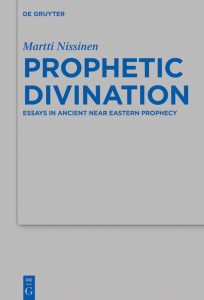 Martti Nissinen. Prophetic Divination: Essays in Ancient Near Eastern Prophecy. Beiträge zur Zeitschrift für die alttestamentliche Wissenschaft 494. Berlin: de Gruyter, 2019.
Martti Nissinen. Prophetic Divination: Essays in Ancient Near Eastern Prophecy. Beiträge zur Zeitschrift für die alttestamentliche Wissenschaft 494. Berlin: de Gruyter, 2019.
The thirty-two essays collected in this volume document Martti Nissinen’s research on the phenomenon of prophetic divination over the time span of a quarter of a century. The volume includes most of my articles on prophecy published in English or German, except for those reworked for the book Ancient Prophecy: Ancient Near Eastern, Biblical, and Greek Perspectives (Oxford: Oxford University Press, 2017). The essays have not been updated, save the cases where the original text contains obvious mistakes, or where exceptionally important new information must have been mentioned. The bibliographies, however, have been standardized, and the references to cuneiform sources have, where necessary, been changed to refer to the newest available text editions.
The first section of the volume discusses prophecy from theoretical perspectives: What kind of a scholarly construction is referred to when the term “prophecy” is used. The second sections contains studies on prophecy in texts from Mari and Assyria and other cuneiform sources from socioreligious, historical, and gender perspectives. The third section discusses biblical prophecy in its ancient Near Eastern context, giving examples of how the comparative method helps to read the biblical prophetic books. Ther fourth section focuses on prophets and prophecy in the Hebrew Bible/Old Testament and the difficulty of reconstructing early Israelite and Judahite prophetic phenomenon from biblical texts. The fifth section includes essays on prophecy and divination in the Dead Sea Scrolls.
See De Gruyter for more infomation.
 Rick Bonnie (2019) Being Jewish in Galilee, 100–200 CE: an archaeological study. Studies in Eastern Mediterranean Archaeology 11. Turnhout: Brepols.
Rick Bonnie (2019) Being Jewish in Galilee, 100–200 CE: an archaeological study. Studies in Eastern Mediterranean Archaeology 11. Turnhout: Brepols.
The period of 100–200 CE was a lively one in the history of Galilee, northern Israel—one leaving a considerable mark upon Jewish history in general. The destruction of the Jerusalem temple in 70 CE, as well as the failures of the two revolts, lead to Galilee becoming the heartland of Jewish settlement in Palestine. Our reconstruction of Galilee’s Jewish community during this period has been primarily informed, however, by a single retrospective voice—the later rabbinic writings. This obviously brings with it certain limitations, not least of which is its reliability. A new source from which to understand the period in question is therefore desirable.
Being Jewish in Galilee, 100–200 CE provides an in-depth archaeological study of Galilee’s Jewish community in the period concerned. It explores evidence of infrastructure, art and architecture, as well as ritual practices from this period in Galilee by drawing comparisons with the period before and by contextualizing this material within the broader cultural environment of the Roman East. Set within debates of cultural interaction in the Roman East in general, the book offers an archaeological understanding of what “being Jewish” meant to the Jewish communities in Galilee during this period; and in what way these communities differed from their Phoenician, Syrian and Arab neighbors.
See Brepols Publishers for more information.
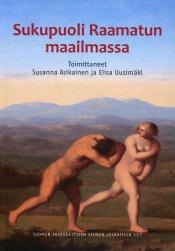 Elisa Uusimäki & Susanna Asikainen, toim. (2019) Sukupuoli Raamatun maailmassa. Suomen eksegeettisen seuran julkaisuja 117.
Elisa Uusimäki & Susanna Asikainen, toim. (2019) Sukupuoli Raamatun maailmassa. Suomen eksegeettisen seuran julkaisuja 117.
Mitä Raamatussa sanotaan sukupuolista ja sukupuolielämästä, miehistä ja naisista? Miten erilaiset käsitykset sukupuolesta ilmenevät paitsi Raamatussa myös muissa aikalaislähteissä? Entä mitä näistä muinaisista lähteistä voidaan sanoa sukupuolentutkimuksen valossa? Sukupuoli Raamatun maailmassa esittelee raamatuntutkimuksen ja sukupuolentutkimuksen leikkauspintoja suomalaiselle yleisölle.
Kirja on ensimmäinen suomenkielinen Raamattua ja sukupuolentutkimusta käsittelevä yleisteos. Se soveltuu sekä aihepiiriin perehdyttäväksi oppikirjaksi että muille aiheesta kiinnostuneille.
Moniääninen teos havainnollistaa sukupuolentutkimuksen rakentumista Raamatun ajan maailmassa erilaisia metodologisia tulokulmia hyödyntäen. Lähestymistavat ulottuvat arkeologiasta tekstintutkimukseen ja eletyn uskonnon viitekehyksestä queer-teoriaan. Raamatun tekstien ohella kirjassa tarkastellaan Qumranin tekstejä, hellenistijuutalaista ja varhaiskristillistä kirjallisuutta ja myöhäisantiikin maailmaa.
Kirja saatavilla Tiedekirjasta.
 Tuukka Kauhanen (2018). Lucifer of Cagliari and the Text of 1-2 Kings. SBL Press.
Tuukka Kauhanen (2018). Lucifer of Cagliari and the Text of 1-2 Kings. SBL Press.
In this book, Tuukka Kauhanen approaches the challenging case of the textual history of 1 and 2 Kings through citations of the text found within the writings of the fourth-century bishop of Sadinia, Lucifer of Cagliari. Kauhanen presents evidence that Lucifer’s Latin text sheds important light on lost Hebrew and Greek pieces of the textual puzzle in Kings. In doing so, he compares all of Lucifer’s extensive quotations of Kings to extant Greek witnesses as well as Old Latin witnesses where available and subsequently analyzes the probable reasons for textual variations. In each instance he attempts to choose the best possible candidate for the Old Greek reading and where that reading might reflect a nowlost Hebrew text.
See SBL Press for more information.
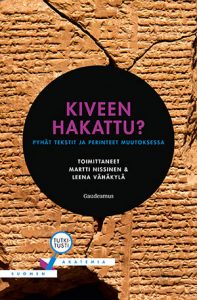 Martti Nissinen & Leena Vähäkylä, toim. (2018) Kiveen hakattu? Pyhät tekstit ja perinteet muutoksessa. Helsinki: Gaudeamus.
Martti Nissinen & Leena Vähäkylä, toim. (2018) Kiveen hakattu? Pyhät tekstit ja perinteet muutoksessa. Helsinki: Gaudeamus.
Tulipalo tuhoaa kaupungin, kivenhakkaajan taltta lipsahtaa, käsikirjoituksen jäljentäjä tekee kynttilänsä valossa kirjoitusvirheen, paperi rasahtaa rikki terävän mustekynän alla.
Pyhät tekstit eivät ole ajan hampaalta ja inhimillisiltä erheiltä suojattuja sen paremmin kuin maallisetkaan hengentuotteet, vaikka Raamattuun ja vanhoihin traditioihin usein liitetään ajatus juuri muuttumattomuudesta.
Tekstit ja perinteet elävät jatkuvasti, toisinaan myös tietoisen valinnan seurauksena: esimerkiksi Paavali siteeraa Vanhan testamentin tekstejä omaan retoriikkaansa sopivasti, ei välttämättä sanatarkasti. Tekstien muutoksiin ovat vaikuttaneet myös kulttuuriset ja yhteiskunnalliset muutokset, esimerkiksi väestönsiirrot, kaupunkien tuhoutumiset sekä erilaisten kulttuuriperinteiden kohtaamiset ja sulautumiset.
Kiveen hakattu? raottaa pyhien tekstien historiaa ja teksteihin tehtyjä perusteltuja ja dokumentoituja muutoksia vieden samalla pohjaa fundamentalismilta. Esimerkiksi Raamatun muuttumattomuus on illuusio: vanhat käsikirjoitukset ovat aina olleet erilaisia sekä kokoonpanoltaan että sisällöltään. Muinaiset tekstit ovat suodattuneet meidän aikaamme lukuisten kirjureiden ja kääntäjien kätten kautta.
Kirja on saatavilla Gaudeamukselta.
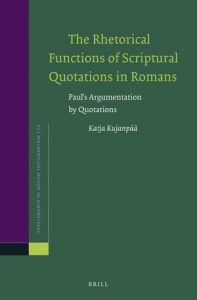 Katja Kujanpää (2018) The Rhetorical Functions of Scriptural Quotations in Romans. Paul’s Argumentation by Quotations. Leiden: Brill.
Katja Kujanpää (2018) The Rhetorical Functions of Scriptural Quotations in Romans. Paul’s Argumentation by Quotations. Leiden: Brill.
Quotations from Jewish scriptures play a crucial role in the Letter to the Romans. The Rhetorical Functions of Scriptural Quotations in Romans explores their rhetorical functions in Paul’s argumentation. It offers a careful text-critical analysis of the 51 quotations in Romans, and asks questions such as: does Paul quote accurately according to a wording known to him or does he adapt it himself? Moreover, to what extent does Paul strive to preserve the sense that the quoted words have in their original context? Katja Kujanpää’s approach of combining rhetorical matters with close textual study results in a more comprehensive picture of quotations in Romans than has been previously seen. Thus, the book opens new perspectives on Paul’s argumentation, rhetoric and theological agenda.
To order this book, please visit Brill.
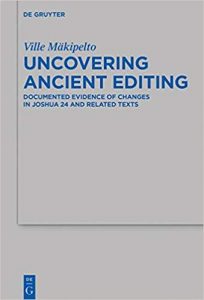 Ville Mäkipelto (2018) Uncovering Ancient Editing: Documented Evidence of Changes in Joshua 24 and Related Texts. Berlin: De Gruyter.
Ville Mäkipelto (2018) Uncovering Ancient Editing: Documented Evidence of Changes in Joshua 24 and Related Texts. Berlin: De Gruyter.
The Hebrew Bible is a product of ancient editing, but to what degree can this editing be uncovered? “Uncovering Ancient Editing” argues that divergent textual witnesses of the same text, so-called documented evidence, should be the starting point for such an endeavor.
The book presents a fresh analysis of Josh 24 and related texts as a test case for refining our knowledge of how scribes edited texts. Josh 24 is envisioned as a gradually growing Persian period text, whose editorial history can be reconstructed with the help of documented evidence preserved in the MT, LXX, and other ancient sources.
This study has major implications for both the study of the book of Joshua and text-historical methodology in general.
To order this book, please visit De Gruyter.
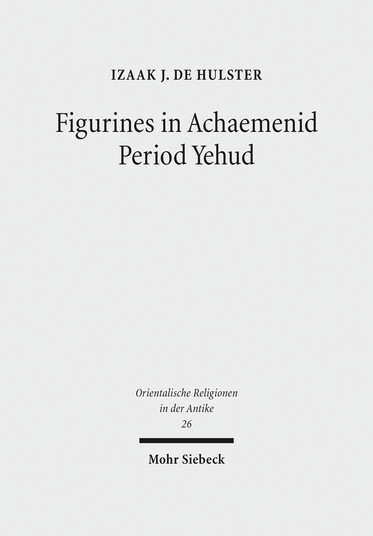 Izaak J. de Hulster (2017) Figurines in Achaemenid Period Yehud. Tübingen: Mohr Siebeck.
Izaak J. de Hulster (2017) Figurines in Achaemenid Period Yehud. Tübingen: Mohr Siebeck.
Going against the present consensus, Izaak J. de Hulster proves in this work that there were figurines in Achaemenid (Persian) period Jerusalem. Some scholars have linked the purported absence of figurines with monotheism; his thesis therefore has implications for Israel’s history of religion after the exile.
Were there figurines in Yehud during the Achaemenid period, and in particular in Jerusalem? A positive answer to this question disproves the general consensus about the absence of figurines in Yehud, which is built on the assumption that the figurines excavated in Judah/Yehud are chronologically indicative for Iron Age II in this area (aside from a few typological exceptions). Ephraim Stern and others have taken this alleged absence of figurines as indicative of Jewish monotheism’s rise. Izaak J. de Hulster refutes this ‘no figurines → monotheism’ paradigm by detailed study of the figurines from Yigal Shiloh’s excavation in the ‘City of David’ (especially their contexts in Stratum 9), providing ample evidence for the presence of figurines in post-587/586 Jerusalem. The author further reflects on the paradigm’s premises in archaeology, history, the history of religion, theology, and biblical studies, and particularly in coroplastics (figurine studies).
To order this book, please visit Mohr Siebeck.
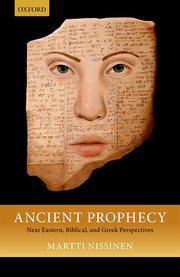 Martti Nissinen (2017) Ancient Prophecy. Near Eastern, Biblical, and Greek Perspectives. Oxford: University Press.
Martti Nissinen (2017) Ancient Prophecy. Near Eastern, Biblical, and Greek Perspectives. Oxford: University Press.
Ancient Prophecy: Near Eastern, Biblical, and Greek Perspectives is the first monograph-length comparative study on prophetic divination in ancient Near Eastern, biblical, and Greek sources. Prophecy is one of the ways humans have believed to become conversant with what is believed to be superhuman knowledge. The prophetic process of communication involves the prophet, her/his audience, and the deity from whom the message allegedly comes from. Martti Nissinen introduces a wealth of ancient sources documenting the prophetic phenomenon around the ancient Eastern Mediterranean, whether cuneiform tablets from Mesopotamia, the Hebrew Bible, Greek inscriptions, or ancient historians.
Nissinen provides an up-to-date presentation of textual sources, the number of which has increased substantially in recent times. In addition, the study includes four analytical comparative chapters. The first demonstrates the altered state of consciousness to be one of the central characteristics of the prophets’ public behavior. The second discusses the prophets’ affiliation with temples, which are the typical venues of the prophetic performance. The third delves into the relationship between prophets and kings, which can be both critical and supportive. The fourth shows gender-inclusiveness to be one of the peculiar features of the prophetic agency, which could be executed by women, men, and genderless persons as well. The ways prophetic divination manifests itself in ancient sources depend not only on the socio-religious position of the prophets in a given society, but also on the genre and purpose of the sources. Nissinen contends that, even though the view of the ancient prophetic landscape is restricted by the fragmentary and secondary nature of the sources, it is possible to reconstruct essential features of prophetic divination at the socio-religious roots of the Western civilization.
To order this book, please visit Oxford University Press.
 Charles Halton and Saana Svärd, eds & trans (2017) Women’s Writing of Ancient Mesopotamia. An Anthology of the Earliest Female Authors. Cambridge: University Press.
Charles Halton and Saana Svärd, eds & trans (2017) Women’s Writing of Ancient Mesopotamia. An Anthology of the Earliest Female Authors. Cambridge: University Press.
Women’s Writing of Ancient Mesopotamia presents fresh and engaging translations of works that were composed or edited by female scribes and elite women of the ancient Near East. These texts provide insight into the social status, struggles, and achievements of women during the earliest periods of recorded human history (c.2300–540 BCE). In three introductory chapters and a concluding chapter, Charles Halton and Saana Svärd provide an overview of the civilization of ancient Mesopotamia and examine gender by analyzing these different kinds of texts. The translations cover a range of genres, including hymns, poems, prayers, letters, inscriptions, and oracles. Each text is accompanied by a short introduction that situates the composition within its ancient environment and explores what it reveals about the lives of women within the ancient world. This anthology will serve as an essential reference book for scholars and students of ancient history, gender studies, and world literature.
To order this book, please visit Cambridge Core.
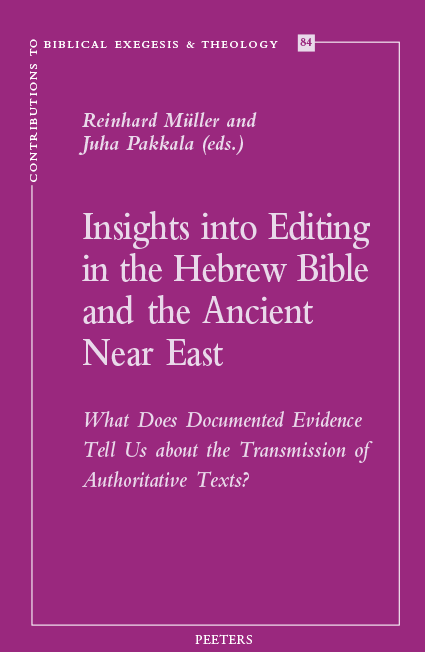 Reinhard Müller and Juha Pakkala, eds (2017) Insights into Editing in the Hebrew Bible and the Ancient Near East. What Does the Documented Evidence Tell Us about the Transmission of Authoritative Texts? Contributions to Biblical Exegesis & Theology 84. Leuven: Peeters.
Reinhard Müller and Juha Pakkala, eds (2017) Insights into Editing in the Hebrew Bible and the Ancient Near East. What Does the Documented Evidence Tell Us about the Transmission of Authoritative Texts? Contributions to Biblical Exegesis & Theology 84. Leuven: Peeters.
Documented evidence has shown that the Hebrew Bible was edited by successive scribes for centuries, and the impact of editing on the resulting text has proven to be crucial. A better understanding of any issue in the Hebrew Bible and ancient Israel requires a deep understanding of the editorial processes. As a consequence, the editorial processes of the Hebrew Bible have come to the fore in the most recent scholarly debates.
Nevertheless, editorial processes in the Hebrew Bible are still poorly understood and a methodological overview is lacking. It is apparent that collaboration between scholars of different fields is needed, and a methodological discussion that takes into account all the editorial techniques witnessed by documented evidence in the Hebrew scriptures and the rest of the ancient Near East is required. This book is a step in this direction. Contributions in this volume by leading scholars approach the issue from various perspectives, including methodology, textual criticism, redaction criticism, Dead Sea Scrolls, Assyriology, and Egyptology.
To order the book, please visit Peeters Publishers.
 Elina Perttilä (2017) Sahidic 1 Samuel – A Daughter Version of the Septuagint 1 Reigns. De Septuaginta Investigationes 8. Göttingen: Vandenhoeck & Ruprecht.
Elina Perttilä (2017) Sahidic 1 Samuel – A Daughter Version of the Septuagint 1 Reigns. De Septuaginta Investigationes 8. Göttingen: Vandenhoeck & Ruprecht.
Elina Perttilä’s study considers the Sahidic version of 1 Samuel as a translation and how it may best be used in Greek textual criticism. The first aim is to examine the translation technique of the Sahidic translator. The second aim is to analyze the affiliations between the Sahidic manuscripts and the affiliations between the Sahidic version and Greek traditions. This translation-technical study will allow a more careful and accurate citation of the Sahidic version within the critical apparatus of the Greek text.
To order the book, please visit Vandenhoeck & Ruprecht.
 Anneli Aejmelaeus and Tuukka Kauhanen, eds (2017) The Legacy of Barthélemy: 50 Years after Les Devanciers d’Aquilla. Göttingen: Vandenhoeck & Ruprecht.
Anneli Aejmelaeus and Tuukka Kauhanen, eds (2017) The Legacy of Barthélemy: 50 Years after Les Devanciers d’Aquilla. Göttingen: Vandenhoeck & Ruprecht.
Les Devanciers d’Aquila by Dominique Barthélemy (1963) is an epoch-making work on the textual history of the Septuagint. On the basis of his analysis of the Nahal Hever Minor Prophets Scroll, Barthélemy developed his theory of an early Hebraizing revision (so-called kaige revision), designed to bring the traditional text of the Septuagint closer to the Hebrew text, and recognized examples of it in the B-text of books such as Joshua, Judges, and Samuel-Kings. The work of these early Hebraizing revisers resembled the later very literal translation by Aquila; hence the name of the book, “the predecessors of Aquila”. Textual scholars of today continue in the footsteps of Barthélemy and work on the same questions that were raised in Devanciers: How extensive was the influence of the kaige revision and how can it be recognized? What is the nature of the Lucianic text: when does it represent the Old Greek and when does it give a stylistically revised text? What is the relationship between the kaige revision and Theodotion’s revision of the Septuagint? The present volume mainly consists of papers presented at the 50th anniversary symposium of Les Devanciers d’Aquila that was held in connection with the SBL International Meeting in St Andrews, Scotland, in 2013. The papers focus on history of research, case studies on the text of Samuel-Kings (1–4 Kingdoms), and studies on the text-historical position of specific witnesses.
To order the book, please visit Vandenhoeck & Ruprecht.
Samuel By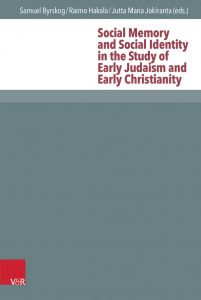 rskog, Raimo Hakola, and Jutta Jokiranta, eds (2016) Social Memory and Social Identity in the Study of Early Judaism and Early Christianity. Novum Testamentum et Orbis Antiquus 116. Göttingen: Vandenhoeck & Ruprecht.
rskog, Raimo Hakola, and Jutta Jokiranta, eds (2016) Social Memory and Social Identity in the Study of Early Judaism and Early Christianity. Novum Testamentum et Orbis Antiquus 116. Göttingen: Vandenhoeck & Ruprecht.
The concepts of social memory and social identity have been increasingly used in the study of ancient Jewish and Christian sources. In this collection of articles, international specialists apply interdisciplinary methodology related to these concepts to early Jewish and Christian sources. The volume offers an up-to-date presentation of how social memory studies and socio-psychological identity approach have been used in the study of Biblical and related literature. The articles examine how Jewish and Christian sources participate in the processes of collective recollection and in this way contribute to the construction of distinctive social identities. The writers demonstrate the benefits of the use of interdisciplinary methodologies in the study of early Judaism and Christianity but also discuss potential problems that have emerged when modern theories have been applied to ancient material.
To order the book, please visit Vandenhoeck & Ruprecht.
Hann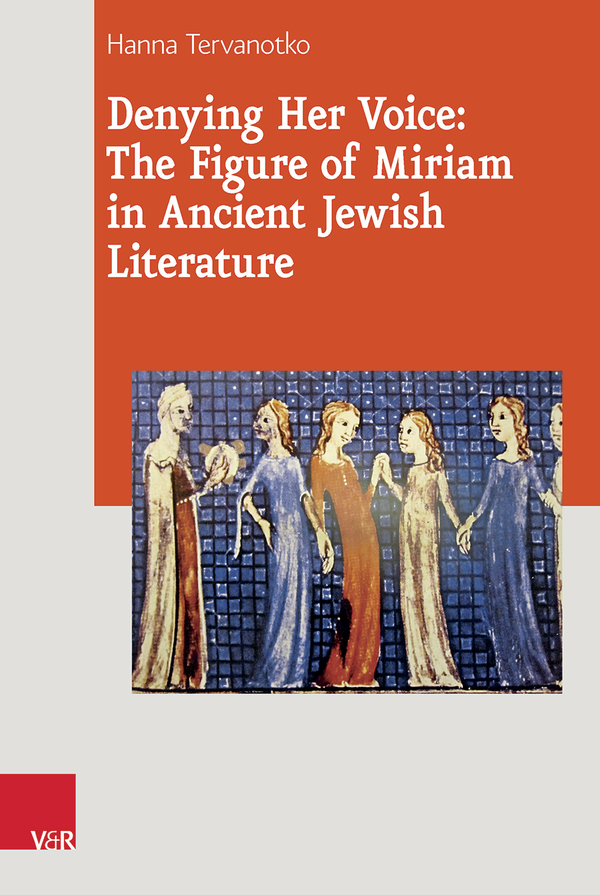 a Tervanotko (2016) Denying Her Voice: The Figure of Miriam in Ancient Jewish Literature. Journal of Ancient Judaism Supplements 23. Göttingen: Vandenhoeck & Ruprecht.
a Tervanotko (2016) Denying Her Voice: The Figure of Miriam in Ancient Jewish Literature. Journal of Ancient Judaism Supplements 23. Göttingen: Vandenhoeck & Ruprecht.
Hanna Tervanotko first analyzes the treatment and development of Miriam as a literary character in ancient Jewish texts, taking into account all the references to this figure preserved in ancient Jewish literature from the exilic period to the early second century C.E. These texts demonstrate that the picture of Miriam preserved in the ancient Jewish texts is richer than the Hebrew Bible suggests. The results provide a contradictory image of Miriam. On the one hand she becomes a tool of Levitical politics, whereas on the other she continues to enjoy a freer role. People continued to interpret earlier literary traditions in light of new situations, and interpretations varied in different contexts. Second, in light of poststructuralist literary studies that treat texts as reflections of specific social situations, Tervanotko argues that the treatment of Miriam in ancient Jewish literature reflects mostly a reality in which women had little space as active agents. Despite the general tendency to allow women only little room, the references to Miriam suggest that at least some prominent women may have enjoyed occasional freedom.
To order the book, please visit Vandenhoeck & Ruprecht.
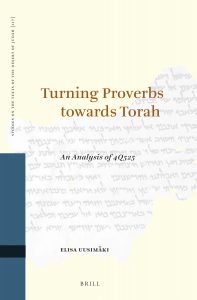 Elisa Uusimäki (2016) Turning Proverbs towards Torah: An Analysis of 4Q525. Studies on the Texts of the Desert of Judah 117. Leiden: Brill.
Elisa Uusimäki (2016) Turning Proverbs towards Torah: An Analysis of 4Q525. Studies on the Texts of the Desert of Judah 117. Leiden: Brill.
In Turning Proverbs towards Torah, Elisa Uusimäki offers the first monograph on the early Jewish wisdom text 4Q525 from Qumran. Following the reconstruction of the fragmentary manuscript, Uusimäki analyses the text with a focus on the reception and renewal of the Proverbs tradition and the ways in which 4Q525 illustrates aspects of Jewish pedagogy in the late Second Temple period. She argues that the author was inspired by Proverbs 1-9 but sought to demonstrate that true wisdom is found in the concept of torah. He also weaved dualistic elements and eschatological ideas into the wisdom frame. The author’s intention, Uusimäki argues, is to form the audience spiritually, encouraging it to trust in divine protection and blessings that are bestowed upon the pious.
To order the book, please visit Brill.
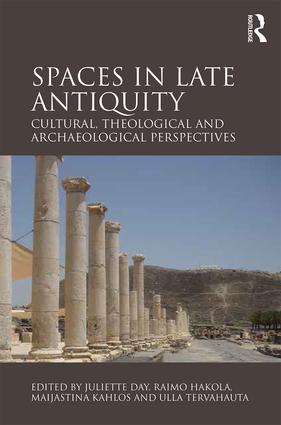 Juliette Day, Raimo Hakola, Maijastina Kahlos, and Ulla Tervahauta (ends) (2016) Spaces in Late Antiquity: Cultural, Theological and Archaeological Perspectives. London: Routledge.
Juliette Day, Raimo Hakola, Maijastina Kahlos, and Ulla Tervahauta (ends) (2016) Spaces in Late Antiquity: Cultural, Theological and Archaeological Perspectives. London: Routledge.
Places and spaces are key factors in how individuals and groups construct their identities. Identity theories have emphasised that the construction of an identity does not follow abstract and universal processes but is also deeply rooted in specific historical, cultural, social and material environments. The essays in this volume explore how various groups in Late Antiquity rooted their identity in special places that were imbued with meanings derived from history and tradition. In Part I, essays explore the tension between the Classical heritage in public, especially urban spaces, in the form of ancient artwork and civic celebrations and the Church’s appropriation of that space through doctrinal disputes and rival public performances. Parts II and III investigate how particular locations expressed, and formed, the theological and social identities of Christian and Jewish groups by bringing together fresh insights from the archaeological and textual evidence. Together the essays here demonstrate how the use and interpretation of shared spaces contributed to the self-identity of specific groups in Late Antiquity and in so doing issued challenges, and caused conflict, with other social and religious groups.
To order the book, please visit Routledge.
Kirsi V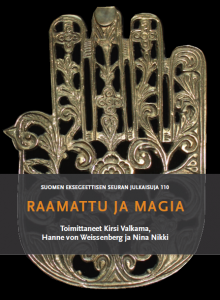 alkama, Hanne von Weissenberg & Nina Nikki (toim.) (2016) Raamattu ja magia. Suomen Eksegeettisen seuran julkaisuja 110. Helsinki: Nord Print.
alkama, Hanne von Weissenberg & Nina Nikki (toim.) (2016) Raamattu ja magia. Suomen Eksegeettisen seuran julkaisuja 110. Helsinki: Nord Print.
Mitä on magia? Onko Raamatussa magiaa? Entä harjoittivatko muinaiset israelilaiset tai ensimmäiset kristityt magiaa? Näihin kysymyksiin ei ole yksiselitteisiä vastauksia, sillä magialle ei ole olemassa yhtä, kaikkien hyväksymää määritelmää. Kirjassa kyseenalaistetaan magian ja uskonnon välinen kahtiajako ja ymmärretään magia yhtenä uskonnollisen toiminnan muotona. Magia on ennen kaikkea tutkijoiden käyttämä ja määrittelemä käsite, joka auttaa ymmärtämään tietynlaisia uskonnollisia ilmiöitä ja ajattelutapoja. Se on käyttökelpoinen käsitteenä, sillä maagisten uskomusten katsotaan kuuluvan ihmismielen luonnollisiin rakenteisiin.
Tässä teoksessa magian käsitettä lähestytään esimerkiksi raamatuntutkimuksen, kognitiivisen uskontotieteen, rituaalitutkimuksen ja arkeologian näkökulmista. Teoksessa käsiteltyjä teemoja ovat magian ilmeneminen Raamatussa, siunaukset ja kiroukset, ihmeet ja parantaminen, henkiolennot ja niitä vastaan suojautuminen sekä suojaavat amuletit ja figuriinit.
To order the book, please visit the website of the Finnish Exegetical Society.
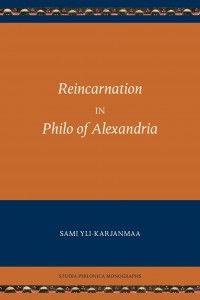 Sami Yli-Karjanmaa (2015). Reincarnation in Philo of Alexandria. Studia Philonica Monograhps 7. Atlanta: Society of Biblical Literature.
Sami Yli-Karjanmaa (2015). Reincarnation in Philo of Alexandria. Studia Philonica Monograhps 7. Atlanta: Society of Biblical Literature.
Philo of Alexandria is the most important representative of Hellenistic diaspora Judaism. His writings, devoted to a large extent to the allegorical exegesis of the Books of Moses, profoundly influenced Christian theology during its formative centuries. The strong element of Greek philosophy in Philo’s thought has been recognized since antiquity, but his relation to the Pythagorean-Platonic tenet of reincarnation has been a neglected, even avoided, topic in research. This book tackles the issue head on and with thorough, detailed research confirms the view—common in the seventeenth to the nineteenth centuries—that Philo accepted the doctrine even though he preferred not to speak openly about it. The book shows how allegorization enabled Philo to give an interpretation involving reincarnation to very different scriptural passages.
To order the book, please visit the Society of Biblical Literature.
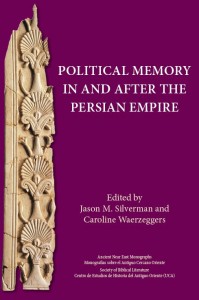 Jason M. Silverman & Caroline Waerzeggers (eds) (2015) Political Memory in and after the Persian Empire. Ancient Near East Monographs 13. Atlanta: SBL.
Jason M. Silverman & Caroline Waerzeggers (eds) (2015) Political Memory in and after the Persian Empire. Ancient Near East Monographs 13. Atlanta: SBL.
This volume results from an international symposium of the same name held in Leiden, the Netherlands, on 18–20 June 2014. The symposium grew out of a recognition that the various disciplines which deal with Achaemenid hegemony over starkly different assessments of Persian kingship. While Assyriologists treat Cyrus’s heirs as legitimate successors of the Babylonian kings, biblical scholars often speak of a “kingless era” in which the priesthood took over the function of the Davidic monarch. Egyptologists see their land as uniquely independently minded despite conquests, while Hellenistic scholarship tends to evaluate the interface between Hellenism and native traditions without reference to the previous two centuries of Persian rule. This discrepancy prompted us to seek a broader context for assessing interactions with the experience of Persian kingship, and to discover how much these differing assessments were due to diversity within the empire and how much they were due to disciplinary assumptions.
The book is open access. To download it, please click here [direct link to PDF] or visit SBL Publications.
Anneli Aejmelaeus, Jutta Jokiranta, Juha Pakkala & Kirsi Valkama (2015) Ihan Täyttä Heprea. Raamatun Heprean Oppikirja. Helsinki: Kirjapaja.
Ihan täyttä hepreaa on uusi Raamatun heprean perusoppikirja, joka tarjoaa opiskelijalle sellaisen kielen osaamisen perustason, jolla hän voi lukea Heprealaista Raamattua sanakirjan avulla.
Ihan täyttä hepreaa johdattaa lukijan Raamatun heprean perusteisiin. Kirjassa käsitellään keskeiset kielioppiasiat, joiden oppimista harjoitukset tukevat. Tärkein sanasto kertautuu tehtävissä, niin että se on helppo omaksua. Harjoitukset on testattu opetustilanteissa Helsingin yliopistossa. Raamatun teksteistä poimitut esimerkit on valikoitu tukemaan perusteiden oppimista. Perustaitojen myötä karttuu kyky käyttää myös muita heprean apuneuvoja kuten kielioppeja ja sanakirjoja.
To order the book, please visit Sacrum.
 Izaak J. de Hulster, Brent A. Strawn & Ryan P. Bonfiglio (eds) (2015) Iconographic Exegesis of the Hebrew Bible / Old Testament: An Introduction to Its Method and Practice. Göttingen: Vandenhoeck & Ruprecht.
Izaak J. de Hulster, Brent A. Strawn & Ryan P. Bonfiglio (eds) (2015) Iconographic Exegesis of the Hebrew Bible / Old Testament: An Introduction to Its Method and Practice. Göttingen: Vandenhoeck & Ruprecht.
Studying ancient visual art that is contemporary with the documents of the Old Testament/Hebrew Bible affords remarkable insight on the meaning and historical context of the biblical text, and also facilitates greater understanding of how the ancient authors and audiences saw, thought, and made sense of the world. Each chapter of this book provides an exegesis of a particular biblical text or theme in light of ancient Near Eastern iconography. The approach on display here enables beginners as well as advanced readers to integrate iconography into their toolbox of exegetical skills and thereby gain a more comprehensive understanding of the biblical text.
To order the book, please visit Vandenoeck & Ruprecht.
Raimo Hak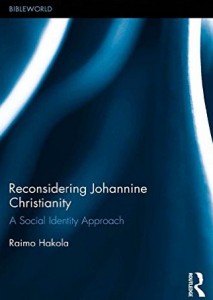 ola (2015). Reconsidering Johannine Christianity: A Social Identity Approach. Bibleworld. New York: Routledge
ola (2015). Reconsidering Johannine Christianity: A Social Identity Approach. Bibleworld. New York: Routledge
Reconsidering Johannine Christianity presents a full-scale application of social identity approach to the Johannine writings. This book reconsiders a widely held scholarly assumption that the writings commonly taken to represent Johannine Christianity – the Gospel of John and the First, Second and Third Epistles of John – reflect the situation of an introverted early Christian group. It claims that dualistic polarities appearing in these texts should be taken as attempts to construct a secure social identity, not as evidence of social isolation. While some scholars (most notably, Richard Bauckham) have argued that the New Testament gospels were not addressed to specific early Christian communities but to all Christians, this book proposes that we should take different branches of early Christianity, not as localized and closed groups, but as imagined communities that envision distinct early Christian identities. It also reassesses the scholarly consensus according to which the Johannine Epistles presuppose and build upon the finished version of the Fourth Gospel and argues that the Johannine tradition, already in its initial stages, was diverse.
To order the book, please visit Routledge.
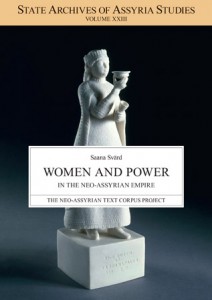 Saana Svärd (2015). Women and Power in Neo-Assyrian Palaces. State Archives of Assyria Studies 23, Helsinki: Neo-Assyrian Text Corpus Project.
Saana Svärd (2015). Women and Power in Neo-Assyrian Palaces. State Archives of Assyria Studies 23, Helsinki: Neo-Assyrian Text Corpus Project.
Power in general and women’s power in particular has been understood mostly in a hierarchical way in earlier research on Mesopotamian women. Hierarchical power structures were important in Mesopotamia, but other kinds of power structures existed as well. This study, which focuses on women in the palaces of the Neo-Assyrian Empire (c. 930–610 BCE), draws attention to heterarchical power relations in which women were engaged in the Neo-Assyrian palace milieu. Heterarchical power relations include power relations such as reciprocal power, resistance, and persuasion. Although earlier research has certainly been aware of women’s influence in the palaces, this study makes explicit the power concepts employed in previous research and further develops them using the concept of heterarchy. The study is based on primary cuneiform sources and presents a detailed description of women in Neo-Assyrian palaces. However, it additionally shows that by applying modern theories of power to the study of ancient texts, one can gain important new insights into the dynamics of ancient society.
To order the book, please visit Eisenbrauns.
 Mika S. Pajunen & Hanna Tervanotko (Eds.) (2015). Crossing Imaginary Boundaries. The Dead Sea Scrolls in the Context of Second Temple Judaism. Publications of the Finnish Exegetical Society 108. Helsinki: Nord Print.
Mika S. Pajunen & Hanna Tervanotko (Eds.) (2015). Crossing Imaginary Boundaries. The Dead Sea Scrolls in the Context of Second Temple Judaism. Publications of the Finnish Exegetical Society 108. Helsinki: Nord Print.
Finnish scholars have been involved in the study of the Dead Sea Scrolls in ever growing numbers since the 1950s. This volume pays tribute to this Helsinki school of Qumran studies, which is presently one of the largest in the world, by presenting the work of the Finnish scholars currently active in this field of study. The contributions of Crossing Imaginary Boundaries explore the Dead Sea Scrolls within the broader context of Second Temple Judaism. The volume challenges the reader to rethink critically the categories and interdisciplinary borders currently used in the study of ancient Jewish texts. In particular, Qumran research has frequently been seen as a limited esoteric area closed off from other areas of Biblical studies. This collection is an attempt to question and bridge some of these imaginary boundaries between scholarly disciplines and to demonstrate the importance of crossing them in order to get a fuller understanding of all these ancient texts and their underlying social phenomena.
To order the book, please visit the bookstore of the Federation of the Finnish Learned Societies (tiedekirja.fi).
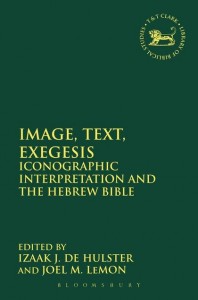 Izaak J. de Hulster & Joel M. LeMon (Eds.) (2014). Image, Text, Exegesis: Iconographic Interpretation and the Hebrew Bible. The Library of Hebrew Bible/Old Testament Studies 588 . London: Bloomsbury T&T Clark.
Izaak J. de Hulster & Joel M. LeMon (Eds.) (2014). Image, Text, Exegesis: Iconographic Interpretation and the Hebrew Bible. The Library of Hebrew Bible/Old Testament Studies 588 . London: Bloomsbury T&T Clark.
Images from the ancient Near East are an important though generally underutilized source of data for interpreting the Hebrew Bible and the cultural context from which it emerged. The essays in this volume highlight the ways that ancient Near Eastern iconography can inform exegesis. This aim is accomplished through case studies in iconographic exegesis that exhibit sound methodologies for relating images and texts. Since the 1970s, biblical scholars have been turning increasingly to iconography as a source for understanding the religion, history and literature of the ancient Near East. The essays in this volume tackle two thorny issues: 1) how images reflect the cultures that produce them and 2) the nature of the relationship between images and texts, both within discrete cultures and among different cultures. Until now, there have been relatively few methodologically self-conscious treatments of ancient iconography and its relationship to the biblical text. So this volume addresses a clear need for demonstrating transparent and consistent methods for iconographic work among biblical scholars.
For ordering the book, please visit the website of Bloomsbury T&T Clark.
 Juha Pakkala, Reinhard Müller & Bas ter Haar Romeny (2014). Evidence of Editing: Growth and Change of Texts in the Hebrew Bible. Resources for Biblical Study 75. Atlanta: Society of Biblical Literature.
Juha Pakkala, Reinhard Müller & Bas ter Haar Romeny (2014). Evidence of Editing: Growth and Change of Texts in the Hebrew Bible. Resources for Biblical Study 75. Atlanta: Society of Biblical Literature.
A new perspective on editorial activity in the Hebrew Bible for research and teaching. Evidence of Editing lays out the case for substantial and frequent editorial activity within the Hebrew Bible. The authors show how editors omitted, expanded, rewrote, and compiled both smaller and larger phrases and passages to address religious and political change. The book refines the exegetical method of literary and redaction criticism, and its results have important consequences for the future use of the Hebrew Bible in historical and theological studies.
For ordering the book, please visit the Society of Biblical Literature.
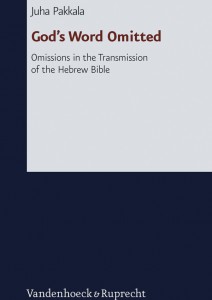 Juha Pakkala (2013). God’s Word Omitted: Omissions in the Transmission of the Hebrew Bible. Göttingen: Vandenhoeck & Ruprecht.
Juha Pakkala (2013). God’s Word Omitted: Omissions in the Transmission of the Hebrew Bible. Göttingen: Vandenhoeck & Ruprecht.
The book investigates omissions in the textual transmission of the Hebrew scriptures. Literary criticism (Literarkritik) commonly assumes that later editors only expanded the older text; omissions would not have taken place. This axiom is implied in analyses and introductions to the methodology. The book investigates the validity of the axiom. After a review of literature, books of methodology, and past research, texts from different parts of the Hebrew Bible are discussed with this aim in view. The investigated texts consist of examples which preserve documented evidence about editorial changes. Passages with variant editions are compared in order to understand omissions as an editorial technique. The comparison of variant witnesses includes, for example, passages where the Greek and Hebrew versions differ and cases where parallel passages differ (e.g., Chronicles in relation to Kings, the Temple Scroll in relation the Pentateuch). Example texts have been taken from the Pentateuch, Samuel, Kings, Ezra-Nehemiah, Esther, Jubilees, etc. The investigation shows that omissions took place in part of the transmission of the Hebrew scriptures. Although omissions were clearly less common than additions, the conclusion challenges the axiom of literary criticism. Rejecting the conventional implementation of the methodology, the book provides a new model for understanding the transmission of the Hebrew scriptures that integrates omissions as a possible editorial technique.
For ordering the book, please visit Vandenhoeck & Ruprecht.

